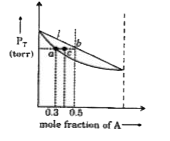In bronze, copper forms fcc arrangement and tin occupies interstitial sites. The density of bronze sample is 7717kgm−3 and its lattice parameter is 3.903 Å. What is the approximate mole fraction of tin in the alloy?
(At. mass of Cu = 63.54u, Sn = 118.7u)Solution in Malayalam
0.01
0.04
0.1
0.4
The correct Answer is:B
In 1 mole of unit cells, there are 4 mol Cu atoms and x mol Sn atoms,
Volume of 1 mole unit cells=(3.903×10−8cm)3×NA=35.79cm3
Mass of 1 mole unit cells=35.79cm3×density=276.2g
Equalising the mass to number of Cu and Sn atoms
4×63.54+x×118.7=276.2⇒x=0.1858
Mole fraction of Sn=0.18584.1858=0.0444
Topper's Solved these Questions
- BOOK - BRILLIANT PUBLICATIONCHAPTER - SOLID STATEEXERCISE - LEVEL-310videos
SOLID STATE
- BOOK - BRILLIANT PUBLICATIONCHAPTER - SOLID STATEEXERCISE - LEVEL-3 (Multiple Correct Answer Type)13videos
SOLID STATE
- BOOK - BRILLIANT PUBLICATIONCHAPTER - SOLID STATEEXERCISE - LEVEL-150videos
SOLID STATE
- BOOK - BRILLIANT PUBLICATIONCHAPTER - REDOX REACTION & ELECTROCHEMISTRYEXERCISE - QUESTION (ELECTROCHEMISTRY) (LEVEL -II) (ASSERTION-REASON)3videos
REDOX REACTION & ELECTROCHEMISTRY
- BOOK - BRILLIANT PUBLICATIONCHAPTER - SOLUTIONSEXERCISE - Level-III (Linked Comprehension Type)12videos
SOLUTIONS
Similar Questions
The unit cell length of NaCl is observed to be 0.5627 nm by X-ray diffraction studies, the measured density of NaCl is 2.164 g cm−3. Calculate % of missing Na+andCl− ions.
03:53View SolutionWhich of the following statements are correct ?
03:00View SolutionThe radius of a di val ent cation M2+ is 94 pm and of divalent anion X2− is 146 pm. Thus, M2X2− has
01:14View SolutionAssertion: After the electrolysis of aqueous CuSO4 solution pH decreases.
Reason: Sulphuric acid is formed.01:33View Solution1 mole of A and 1 mole B are mixed together to form an ideal solution at 25∘C. Solution is placed in a vessel fitted with piston. If pressure on the solution is reduced isothermally.

Correct relationship between P∘AandP∘B isView SolutionThe atomic fraction (d) of tin in bronze (fcc) with a density of 7717kgm−3 and a lattice parameter of 3.903Å is (AwCu=63.54,Sn=118.7,1aμ=1.66×10−27kg)
01:04View Solution60 kg मिश्रधातु A को 100 kg मिश्रधातु B के साथ मिश्रित किया जाता है यदि मिश्रधातु में सीसा और टिन 3:2 के अनुपात में हो और मिश्रधातु B में टिन और तांबा 1:4 के अनुपात में हो नयी मिश्रधातु में टिन के मात्रा होगी !
01:48View SolutionTin bronze is
01:59View SolutionWhich of the following elements is alloyed with copper to form bronze?
05:45View SolutionAssertion (A): The metals and alloys are good conductors of electricity.
Reason (R) : Bronze is an alloy of copper and tin and it is not a good conductor of electricity.04:18View SolutionThe ratio of Cu and Sn metals in bronze
04:57View Solution___________ is an alloy of copper and tin. (Brass/Bronze)
View SolutionFill in the blanks by selecting correct word/term given in the brackets.
An alloy of copper and tin is called __________ .(brass/bronze)04:57View SolutionThe atomic fraction (d) of tin in bronze (fcc) with a density of 7717kgm−3 and a lattice parameter of 3.903Å is (AwCu=63.54,Sn=118.7,1aμ=1.66×10−27kg)
02:57View SolutionIn bronze, copper forms fcc arrangement and tin occupies interstitial sites. The density of bronze sample is 7717 kg m^(-3) and its lattice parameter is 3.903 Å. What is the approximate mole fraction of tin in the alloy? (At. mass of Cu = 63.54u, Sn = 118.7u)
02:02View Solution

